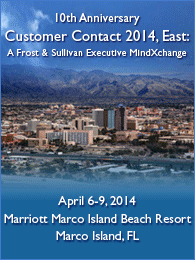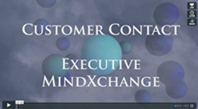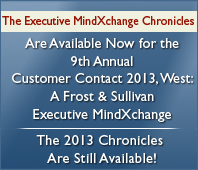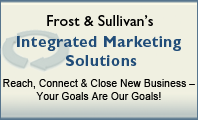Why the Customer Experience Matters!
 |
By Sean Graham
Director of Sales
Blinds.com
|
|
Frost & Sullivan’s
Executive MindXchange Chronicles collect the key take-aways and best practices from all of our Executive MindXchange events so attendees can bring back the best ideas to implement in their own companies, and those who missed the event can access all of the most important information.
This excerpt from the 9th Annual Customer Contact 2013, West: A Frost & Sullivan Executive MindXchange features just a sampling of what the Chronicles have to offer.
_______________________________________________
Session:
Why the Customer Experience Matters!
Facilitator:
Sean Graham, Director of Sales, Blinds.com
______________________________________________
In call centers, extraordinary service and an amazing customer experience can contribute to huge increases in lifetime value. But how do you define a great customer experience, and better yet, get that embedded into your culture? In this session, Sean Graham, Director of Sales at Blinds.com, shared the secrets learned by his company, which has won three Best Places to Work awards.
Take-Away:
The customer experience starts with the employees, Graham said. Therefore, it is important to create a positive environment for employees to work in. A culture of competency is always better than a culture of compliance. When employees feel empowered, so do customers.
Best Practice(s):
At Blinds.com, employees use an “inspiration board” to share plans such as “I want to lose five pounds,” or “I want to go back to school.” Then, the company encourages them to do those things. Having support on a personal as well as professional level makes agents want to show up to work every day.
The company also encourages success by using performance-based compensation – or, as Graham called it, a “skills pay the bills” approach. If the agents handle their calls well, they receive a commission. This way, everyone is incentivized to do the right thing for the customer at every point of interaction – not just salespeople.
Take-Away:
As Graham pointed out, improving customer service is cheaper than bringing new customers on board. So much marketing money is spent to frame a product as perfect, but what happens when the customer has a problem with it? They call customer service. Even if a product isn’t the cheapest in the marketplace, customers will stick with the company if they receive excellent service.
Best Practice(s):
Blinds.com empowers employees to make emotional connections with customers. Graham described a situation in which one customer called in to make an order to replace blinds that her dog had destroyed. The customer service representative and the customer connected on their love for dogs, and when the blinds arrived at the customer’s house, she was surprised to also find a dog chew toy included in the packaging. Because the CSR was able to expend a little extra effort to make a deep personal connection with the customer, the customer will likely return to Blinds.com with any future business.
While many companies view customer service as a cost center, Graham views it as a profit center. Lifetime value is more important than anything, Graham said. In seven to ten years, when customers need new blinds, they will come back to Blinds.com because of the excellent customer service they received.
Take-Away:
Buyers love to buy from companies intent on doing things right. Excellent customer service can even lead customers to spend a few extra dollars on a product. That’s why companies must make sure that customer service is one of the reasons that people choose to do business with the company.
Best Practice(s):
Graham cited the examples of companies such as Zappos, which grew from selling just shoes to clothes and accessories, and Amazon, which grew well beyond selling books. One of the top reasons for those successes was that the companies were getting support from customers that loved their customer experience.
One time, a Fedex truck carrying several Blinds.com orders drove off the road, Graham said, and those orders were damaged as a result. Customer service contacted the customers to inform them of the situation, and the company remade the blinds and rushed them to the customers at no additional cost. The key in this situation was that customer service was proactive – agents didn’t wait to speak with the affected customers when they called in to complain that their orders hadn’t arrived.
Action Items(s) to Implement:
Graham stressed the importance of being proactive in contacting customers when an issue arises and receptive to their requests or concerns.
It’s also important for companies to keep in mind that customer service is everyone’s job. That means all parts of the organization need to work together so that if there’s a problem, everyone in the company can help fix it.
Final Thought:
The “wow” factor in customer service does matter, Graham said. If agents can create a “wow” experience with customers, those people will continue to come back to the company. Great service is everyone’s job, from the CEO to the CSR.
Companies need to empower the service team and give them the ability to make things happen. Trust them and let them run with the business, because they will make or break the company every single day. Amazing customer service should be an organization’s
primary mission.
Want to learn more? Frost & Sullivan’s
Executive MindXchange Chronicles collect detailed summaries of all the keynote speeches, presentations, and interactive sessions from the 9th Annual Customer Contact 2013, West: A Frost & Sullivan Executive MindXchange. |
|



Other Upcoming Frost & Sullivan Executive MindXchange Events:
10th Anniversary
Customer Contact 2014, West
October 19-22, 2014
Coronado, CA



››
Wowing the Customer: Uncomplicated Performance Management to Improve
the Customer Journey
Mar 27 2014, at
2pm EDT

››
Using the Cloud to Enhance the Customer
Experience
Now On Demand
››
Using Cloud Communications for a
Competitive Advantage
Now On Demand
››
Putting the Self into IVR
Self-Service: Perfecting the Self-Service Model to Improve the
Customer Experience
Now
On Demand
››
A Case Study in Customer Contact Transformation
Now On Demand
››
The Rising Cost of Customer Service: Delivering Higher Reliability and a
Competitive Edge
Now On Demand
››
Journey to the Center of
Omni-channel Excellence
Now On Demand
››
Optimizing Your Unique Multi-touch Customer Support Strategy
Now On Demand

















|
No comments:
Post a Comment